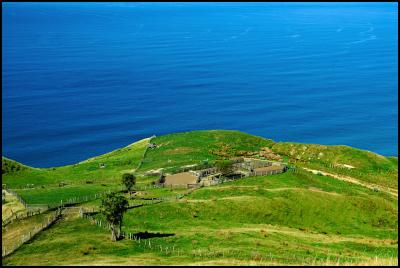Buzzing farm delivers a hive of primary production activity
Media Release
24.11.2016

The modern face of
traditional farming in Northern Hawke’s Bay – Te Au
Station which derives income from multiple revenue streams
– has been placed on the market for
sale.
Buzzing coastal farm delivers a hive of primary production activity
A coastal sheep and beef farm with growing revenues from honey production and tourism has been placed on the market for sale.
Te Au Station near the entrance of Mahia Peninsula in northern Hawke’s Bay is a 710 hectare waterfront property traditionally capable of carrying approximately 4500 stock units.
However, entrepreneurial owners Malcolm and June Rough have been diversifying their asset’s revenue streams over the past decade through the development of several complimentary farm operations.
Over the past few years the freehold property has been steadily building up the volume of its honey production, and is now home to some 350 hives – well up from the 250 hives used at the same time last year.
In addition, Te Au Station operates a fully self-contained luxury ‘cottage’ which sleeps eight guests and has been let as tourist accommodation – with guests taking advantage of Te Au’s privately-accessed trout-rich river.
After 23-years on the land building up the business in all its formats, owners Malcolm and June Rough have placed the property for sale through Bayleys Gisborne – with offers being taken until January 26, 2017.
Bayleys Gisborne director James Macpherson said that by broadening Te Au’s economic activities in several directions, the potential buyer pool for the property was wide-ranging.
“Te Au Station’s business model is representative of where many farms are now heading in New Zealand – utilising the traditional and established productive sector as a foundation, then adding on other revenue streams. In this case, the commercial accommodation and apiary activities,” Mr Macpherson said.
“It’s a financially sensible approach, as the diversity of revenue streams helps smooth over any operational troughs which may arise from the primary activity – which in Te Au’s case is sheep and beef rearing and grazing.
“The abundance of trout in the almost three kilometres stretch of Kopuawhara River running through the property underpins the attraction of the lodge-style dwelling - with trout fishing enthusiasts appreciating access to the fishery towards the rear of the farm.
“The property also has extensive ocean frontage for guests seeking to undertake sea fishing as an alternative leisure activity, or take advantage of Mahia peninsula’s nationally renowned beaches.”
Water on the property is derived from a variety of streams and springs, complimented by multiple man-made dams. The locality has a recorded average rainfall of
1600 mm, with the farm’s altitude ranging from sea level to 370 metres.
“In the 23 years which the current owners have run Te Au Station the farm has only browned off twice,” Mr Macpherson said.
The property is subdivided into 28 paddocks with post and baton wire fencing, and is served by a well-maintained network of tracks and access lanes. The farm has been thoroughly fertilised – with 90 tonnes of sulphur super spread over the past five seasons and 15 hectares of pasture sown in new grass.
Farm building infrastructure includes two three-bay lockable implement sheds. Meanwhile, the farm homestead is a 600 square metre four-bedroom/three bathroom villa with extensive veranda decking overlooking an in-ground salt water swimming pool and BBQ patio area with views over Mahia Peninsula. The fully self-contained short-let is located nearby.
The farm contains two QEII
Trust native reserves totaling 58 hectares of plantings,
with a further 60 hectares of bush adjacent to gullies and
streams.


 Vegetables New Zealand: Asparagus Season In Full Flight: Get It While You Still Can
Vegetables New Zealand: Asparagus Season In Full Flight: Get It While You Still Can  Bill Bennett: Download Weekly - How would NZ telecoms cope with another cyclone
Bill Bennett: Download Weekly - How would NZ telecoms cope with another cyclone NZ On Air: Firm Audience Favourites Lead NZ On Air Non-Fiction Funding
NZ On Air: Firm Audience Favourites Lead NZ On Air Non-Fiction Funding Insurance and Financial Services Ombudsman: Woman Gets $40k More After Disputing Insurer’s Decision
Insurance and Financial Services Ombudsman: Woman Gets $40k More After Disputing Insurer’s Decision BNZ: A Quarter Of Older NZers Fear Going Online Due To Scam Concerns
BNZ: A Quarter Of Older NZers Fear Going Online Due To Scam Concerns University of Auckland: Scientists Develop Tool To Monitor Coastal Erosion In Fine Detail
University of Auckland: Scientists Develop Tool To Monitor Coastal Erosion In Fine Detail



